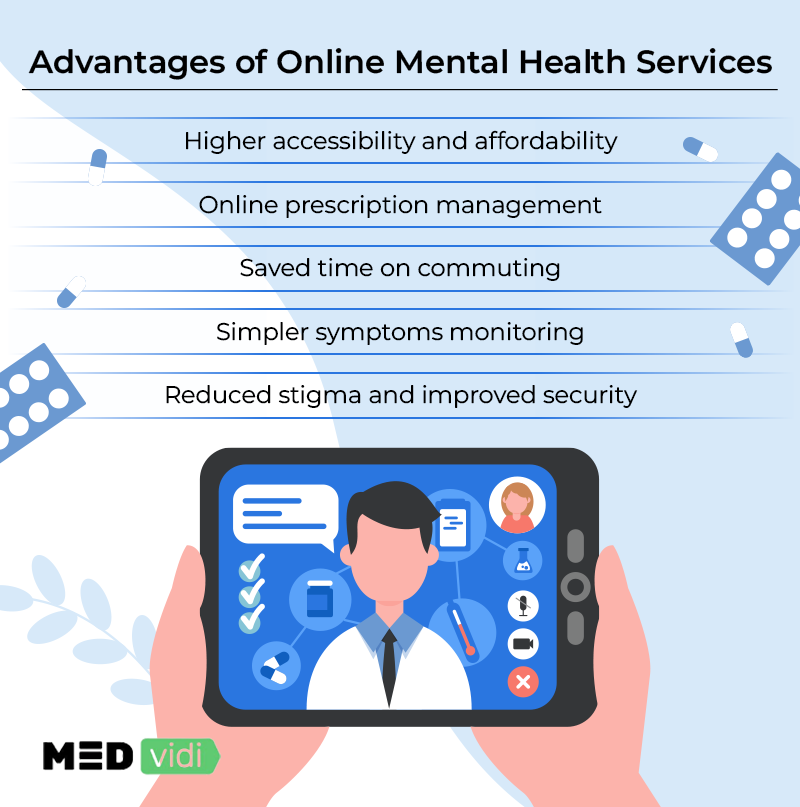The Covid-19 pandemic illuminated the numerous possibilities that technology offers. Telehealth emerged as a service that most healthcare professionals embraced. A stable Internet connection and your smartphone are all you ought to have now to receive help online.
In the United States,
Click the button below to see a mental health professional within 24 hours.
From Limited Opportunities to Higher Accessibility
Mental health patients often fail to receive regular treatment due to difficulty accessing mental health professionals. For instance, rural patients must travel to towns and cities to seek professional help. Therefore, they must set aside a specific day to see their therapist.
Additionally,
Therefore, with mental health telehealth, you don’t have to wait for your condition to get worse or travel to urban areas to see your therapist. You can access mental health treatment from the comfort of your home despite the distance between you and your counselor. Whether they are in the same state or a different one, you consistently have therapy sessions online.
Furthermore, you have access to professionals who speak the language that best suits you ensuring you communicate accurately. This way, you receive the best mental healthcare services. Therefore, through telemedicine, more patients have access to mental healthcare regardless of distance and location.
From Financial Constraints to Affordability
For some patients, a visit to their healthcare provider means they have to ask for time off from work, hire a babysitter and cater for transport costs. Statistics indicate Americans generally spend
Telehealth services for mental health eliminate transportation costs and absenteeism at work. Instead, you can schedule a counseling session before or after work. Therefore, virtual mental health services will help reduce the financial strain while receiving treatment.
From the Compex Symptoms Monitoring to a Simple Follow-Up System
Patients regularly used to cancel follow-up sessions with their therapists due to various emergencies at work or at home. For patients with disabilities, the therapist may have had to travel to their homes and they still had other patients to consult in the office. All of that could make patient monitoring less frequent and therefore less effective.
However, telehealth counseling ensures regular monitoring and consistent patient follow-up. A mental health practitioner can virtually communicate appointments, rearrange dates, modify treatment plans, and provide mental health information helpful to patients and caregivers.
Telehealth professionals can help patients install the software and equipment needed for mental health telemedicine. Then, they have more opportunities to be aware of the patient’s progress and ensure active participation from the patient as they pursue mental wellness.
Doctors can have short video conferencing calls with their patients to follow up on their progress. Besides, a virtual check-in form helps to monitor how well the patient attends the counseling sessions. Finally, since there is no need for commuting, patients can schedule appointments choosing from a wider number of convenient time slots, which results in fewer cancellations.
MEDvidi doctors will support you along the way. Start your journey to mental well-being today!

From Time-Consuming Commuting to Visits from Wherever the Patient is
A visit to the therapist consumes time during the drive to and from and waiting in line. Sometimes, a patient may come in requiring urgent care, forcing the ones in line to stay longer. Patients or their caregivers can use the time spent in the commute and waiting line to handle other tasks.
Therefore, telehealth mental health counseling has eliminated these time-consuming scenarios for patients. Mental healthcare providers can now answer their patients’ needs on time, and waiting is no longer tedious for patients. There is also no need to spend so much time commuting to a clinic to have quick appointments for prescription refills. A doctor can revise the symptoms and progress via a video visit and make a refill online, and send the new prescription directly to the pharmacy. Moreover, some online mental health clinics offer medication delivered right to your door, so you won’t need to go to the pharmacy either.
Telehealth service for mental health also reduces queueing time in healthcare facilities for those who can only attend appointments in person due to their treatment specifics. However, these people still get an advantage with telehealth platforms since they can book their visit online in a few clicks. There is also no need to wait for the clinic’s staff to confirm when the doctor is available.
From Stigma to Respect and Security
Many people fail to seek mental healthcare services due to the stigma that comes with mental disorders. Individuals fear receiving
Although they know they need medical care, they lack support from society and friends. Resultantly, they’ll fail to seek medical attention leading to adverse effects. More anxiety caused by stigma could further worsen their mental health, especially in cases of anxiety disorders.
Mental health telemedicine offers alternatives to psychological consultations held in traditional clinics. Online appointments allow patients to receive mental health care in the comfort of their homes. As a result, they can maintain privacy and reduce stigma as they receive mental health treatment.
In Closing
Undoubtedly, telemedicine has numerous benefits in mental health treatment. A bit of training for the patients and medical personnel will ensure smooth processes. Besides, with technology becoming a vital part of life, mental health telemedicine is the way to go. If you doubt seeing a professional because of any challenges or concerns mentioned above, have a look at how they can be avoided with MEDvidi. Book an online video appointment today, discuss your symptoms and concerns with a licensed MD in your state, and the treatment and support you need.













